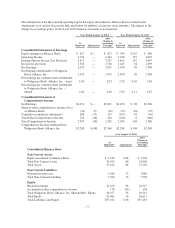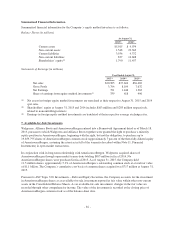Walgreens 2015 Annual Report Download - page 80
Download and view the complete annual report
Please find page 80 of the 2015 Walgreens annual report below. You can navigate through the pages in the report by either clicking on the pages listed below, or by using the keyword search tool below to find specific information within the annual report.
periods beginning after December 15, 2017 (fiscal 2019). Early adoption is permitted for annual reporting
periods beginning after December 15, 2016 (fiscal 2018). ASU 2014-09 provides a new revenue recognition
standard with a five-step analysis of transactions to determine when and how revenue is recognized. The core
principle is that a company should recognize revenue to depict the transfer of promised goods or services to
customers in an amount that reflects the consideration to which the entity expects to be entitled in exchange for
those goods or services. The Company is evaluating the effect of adopting this new accounting guidance.
In July 2015, the FASB issued ASU 2015-11, Inventory (Topic 330). This ASU simplifies current accounting
treatments by requiring entities to measure most inventories at “the lower of cost and net realizable value” rather
than using lower of cost or market. This guidance does not apply to inventories measured using last-in, first-out
(LIFO) method or the retail inventory method (RIM). This ASU is effective prospectively for annual periods
beginning after December 15, 2016 and interim periods thereafter (fiscal 2018) with early adoption permitted.
Upon transition, entities must disclose the accounting change. The Company is evaluating the effect of adopting
this new accounting guidance but does not expect adoption will have a material impact on the Company’s results
of operations, cash flows or financial position.
In November 2014, the FASB issued ASU 2014-17, Pushdown Accounting. This ASU provides companies with
the option to apply pushdown accounting in its separate financial statements upon occurrence of an event in
which an acquirer obtains control of the acquired entity. The election to apply pushdown accounting can be made
either in the period in which the change of control occurred, or in a subsequent period. This ASU is effective as
of November 18, 2014. The adoption did not have a material impact on the Company’s results of operations, cash
flows or financial position.
In April 2014, the FASB issued ASU 2014-08, Reporting Discontinued Operations and Disclosures of Disposals
of Components of an Entity. This ASU raises the threshold for a disposal to qualify as discontinued operations
and requires new disclosures for individually material disposal transactions that do not meet the definition of a
discontinued operation. Under the new standard, companies report discontinued operations when they have a
disposal that represents a strategic shift that has or will have a major impact on operations or financial results.
This update will be applied prospectively and is effective for annual periods, and interim periods within those
years, beginning after December 15, 2014 (fiscal 2016). Early adoption is permitted provided the disposal was
not previously disclosed. This update will not have a material impact on the Company’s reported results of
operations and financial position. The impact is non-cash in nature and will not affect the Company’s cash
position.
3. Change in Accounting Policy
Walgreens historically accounted for its investment and proportionate share of earnings in Alliance Boots
utilizing a three-month reporting lag. Concurrent with the completion of the Second Step Transaction, the
Company eliminated the three-month reporting lag. The Company determined that the elimination of the three-
month reporting lag was preferable because having Alliance Boots and its subsidiaries have the same period-end
reporting date improves overall financial reporting as business performance is reflected in the Company’s
consolidated financial statements on a more timely basis.
In accordance with ASC Topic 810, Consolidation, a change to eliminate a previously existing reporting lag is
considered a change in accounting principle in accordance with ASC Topic 250, Accounting Changes and Error
Corrections. Changes in accounting principles are to be reported through retrospective application of the new
principle to all prior financial statement periods presented. Accordingly, the consolidated financial statements
have been recast to reflect the period specific effects of eliminating the three-month reporting lag. The
acquisition of the initial 45% interest was reflected in the Company’s August 31, 2012 balance sheet. The
Company’s equity earnings and income statement for the year ended August 31, 2012 were not recasted as the
impact was not material.
-76-
























